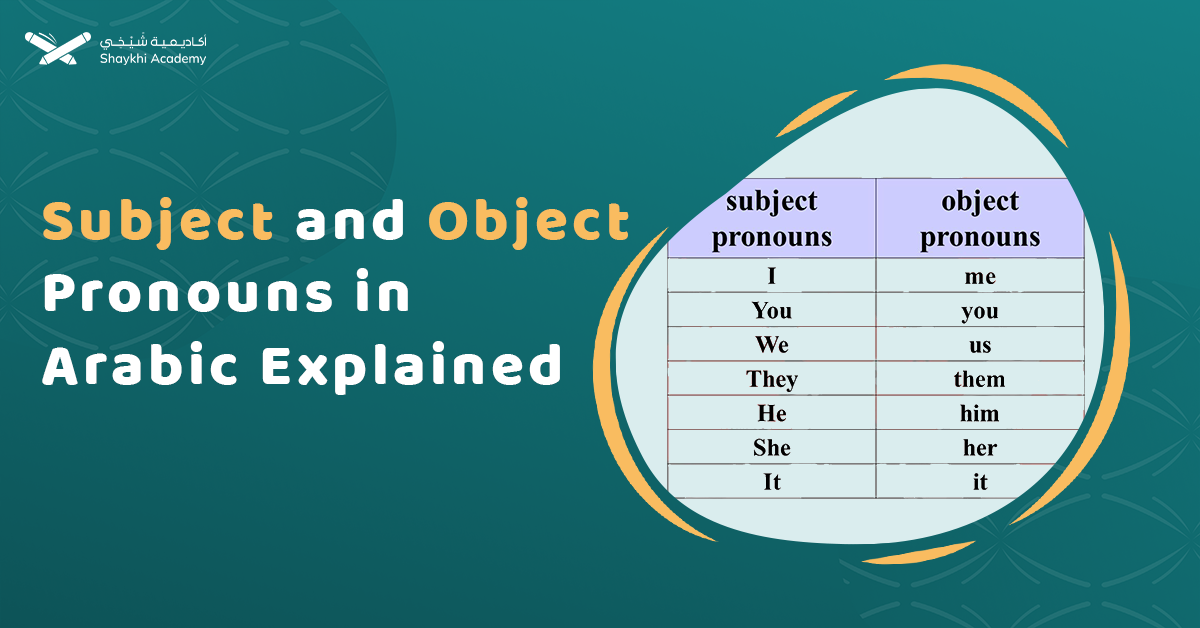Arabic object pronouns are suffixes that indicate the direct or indirect object of a verb, adapting to gender and number. They can be attached to verbs, prepositions, or nouns and are often inferred from verb conjugations, appearing explicitly only for emphasis or clarity.
What Are Arabic Object Pronouns?
Arabic object pronouns are an essential component of sentence structure in the language. These pronouns help to indicate the direct or indirect object of the verb and often appear as suffixes attached directly to verbs, prepositions, or nouns. Understanding the usage of object pronouns is crucial for creating grammatically correct and meaningful sentences.
The object pronoun replaces the object in an Arabic sentence, taking all of its characteristics and functions.
In the basic Arabic language syntax, the object pronoun does not appear separately as an independent word, instead It is attached to the end of the sentence’s main verb. It can be realized by deducing it from the verb’s conjugations.
Arabic Object Pronouns Chart
Here is a chart of the object pronouns in the Arabic language with their English equivalents and their short forms that appear in the Arabic sentence structure.
| Pronoun | Arabic Pronoun | Transliteration | Example Sentence (English) | Example Sentence (Arabic) |
| I | -ني | -ni | He loves me. | هو يحبني. (Huwa yuhibuni.) |
| You (m.) | -كَ | -ka | I see you. | أنا أراكَ. (Ana araka.) |
| You (f.) | -كِ | -ki | I see you. | أنا أراكِ. (Ana araki.) |
| He | -هُ | -hu | I see him. | أنا أراهُ. (Ana arahu.) |
| She | -ها | -ha | I see her. | أنا أراها. (Ana araha.) |
| It (m.) | -هُ | -hu | I love it. | أنا أحبهُ. (Ana uhibbuhu.) |
| It (f.) | -ها | -ha | I love it. | أنا أحبها. (Ana uhibbuha.) |
| We | -نا | -na | He loves us. | هو يحبنا. (Huwa yuhibuna.) |
| You (pl.) | -كم | -kum | I see you. | أنا أراكم. (Ana arakum.) |
| They (m.) | -هم | -hum | I see them. | أنا أراهم. (Ana arahum.) |
| They (f.) | -هنّ | -hunna | I see them. | أنا أراهنّ. (Ana arahunna.) |
Arabic Object Pronouns Examples
In the Arabic language, object pronouns appear as suffixes that are attached to the end of the sentence’s main verb. Via contextual demonstrative examples, we can grasp their usages in the Arabic language structure.
Here are some examples of the object pronouns. Pay attention to the words or initials.
| Sentence | Arabic | Transliteration | Learner Description Note |
| 1. My father kissed me. | قَبلَنّي أَبْي. | Qabalani abee. | This sentence demonstrates the use of the object pronoun “ني” (ni) for “me” in the accusative case. The verb “قبل” (kissed) is conjugated to reflect the action directed at the speaker. |
| 2. The teacher helped us. | سَاعَدْنا المُعَلِم. | Sa3adana al-Moaelim. | “نا” (na) is the object pronoun for “us,” used with the verb “ساعد” (helped) in its past tense form. |
| 3. The teacher visited you. (masculine singular) | زَارَكَ المُعَلمْ | Zaraka al-Moaelim. | “كَ” (ka) is the object pronoun for “you” (masculine singular), showing how the pronoun is attached to the verb. |
| 4. The teacher visited you. (feminine singular) | زَارَكِ المُعَلمْ | Zarakee al-Moaelim. | “كِ” (ki) is the object pronoun for “you” (feminine singular), showing the gender difference in Arabic object pronouns. |
| 5. I love both of you. | أَنْا أُحِبَكُما. | Ana ohebakoma. | “كما” (kuma) is the dual object pronoun for “both of you,” used when referring to two people. |
| 6. I love you, boys. | أَنْا أُحبَكُم، يَا أَولَاد. | Ana ohebakom ya awlad. | “كُم” (kum) is the plural masculine object pronoun, indicating “you” in the plural form (masculine). |
| 7. I will visit you, girls. | سَأْزورَكُن يْا بَنْات. | Sa’azorakon ya banat. | “كُن” (kun) is the plural feminine object pronoun, indicating “you” in the plural form (feminine). |
| 8. I loved him. | أَحْببتَه | Ahababtaho. | “ه” (ho) is the object pronoun for “him,” used with the verb “أحب” (loved) in its past tense form. |
| 9. I loved her. | أَحْببتَها. | Ahibibtaha. | “ها” (ha) is the object pronoun for “her,” reflecting the feminine object in the past tense. |
| 10. I loved both of them. | أَحْببتَهُما. | Ahibibitahoma. | “هما” (huma) is the dual object pronoun for “both of them,” used to indicate two people or things. |
| 11. I saw them playing. | رَأْيتَهُم يَلعَبون. | Ra’aetahom yal3aboon. | “هُم” (hom) is the plural masculine object pronoun, indicating “them” in the masculine plural form. |
| 12. I saw them crying. | رَأَيتَهُن يَبْكُون. | Ra’aetahon ya’bkoon. | “هُن” (hon) is the plural feminine object pronoun, indicating “them” in the feminine plural form. |
Position of Arabic Object Pronouns
In Arabic, object pronouns generally appear as suffixes attached to the verb or preposition. Unlike English, where the object pronoun typically comes after the verb (e.g., “I see her”), in Arabic, the object pronoun is appended directly to the verb:
- Example: “I see him” becomes “أنا أراهُ” (Ana arahu), where “هُ” is the object pronoun for “him.”
Arabic Object Pronouns Are Changed Based On Gender and Number
Arabic object pronouns also change based on the gender (masculine or feminine) and number (singular, dual, or plural) of the object:
- Singular Pronouns: For example, “him” (هو) or “her” (هي).
- Dual Pronouns: Used when referring to two people or things. For example, “them” (both masculine) becomes “هما” (humā), and for both feminine, it becomes “هما” (humā) as well.
- Plural Pronouns: Used when referring to more than two. For example, “them” (masculine plural) becomes “هم” (hum), and “them” (feminine plural) becomes “هن” (hunna).
Emphasis on Pronouns Using Object Pronouns
In some cases, you may wish to emphasize the object pronoun for clarity or to highlight the object. In these cases, Arabic uses the independent form of the pronoun (هو, هي, هم, etc.) instead of the suffix form:
- Example: “He sees her” can be written as “هو يرى هي” (Huwa yara hīya), where the object pronoun “هي” (hīya) is written explicitly to emphasize “her.”
- In non-main verb sentences, it becomes crucial to use the full object pronoun for clarity: “أنا أراكِ جيداً” (Ana arāki jīdan) meaning “I see you well,” here the focus is on the “you.”
Hidden Arabic Object Pronouns
In many Arabic sentences, the object pronoun may not always be explicitly stated. The reader can infer the object from the verb’s conjugation or context. In Arabic, the subject and sometimes the object pronoun is implicit in the verb conjugation:
- Example: “I see him” is often written as “أراهُ” (Arāhu), where “أنا” (I) is understood from the verb form, and the object pronoun “هُ” (him) is inferred from the conjugation of the verb.
Arabic Object Pronouns Use in Context
Here are some more detailed examples of how these pronouns work in sentences:
- First Person Singular: “I see him” becomes “أنا أراهُ” (Ana arāhu).
- Second Person Singular Masculine: “I see you” becomes “أنا أراكَ” (Ana arāka).
- Second Person Singular Feminine: “I see you” becomes “أنا أراكِ” (Ana arāki).
- Third Person Singular Masculine: “I see him” becomes “أنا أراهُ” (Ana arāhu).
- Third Person Singular Feminine: “I see her” becomes “أنا أراها” (Ana arāhā).
- First Person Plural: “I see us” becomes “أنا نراكم” (Ana narākum).
- Second Person Plural Masculine: “I see you all” becomes “أنا أراكم” (Ana arākum).
- Third Person Plural Feminine: “I see them” becomes “أنا أراهنّ” (Ana arāhunna).
Compare The Arabic Object Pronouns With The Arabic Subject Pronouns:
Arabic subject and object pronouns are essential elements of sentence structure, reflecting the gender, number, and grammatical roles of subjects and objects. The table below summarizes their primary forms and usage for learners.
| Type | Explanation | Example | Translation |
| Subject Pronouns | Replace the sentence’s subject, aligning with gender, number, and verb conjugations. Can be apparent or hidden. | أنا سعيدٌ (Ana sa’idun) | I am happy |
| أحب التفاح (O’hebbo at-Tofaha) | I love apples | ||
| Object Pronouns | Replace the object of a sentence and appear as suffixes attached to verbs, reflecting the object’s characteristics. | ساعدنا المعلم (Sa’adana al-Mo’allem) | The teacher helped us |
| أحببتها (Ahbabtaha) | I loved her |
For a detailed breakdown of these pronouns and their grammatical functions, Shaykhi Academy offers in-depth lessons with practical examples.
Start Your Worthwhile Journey of Learning Arabic Object Pronouns with Shaykhi Academy
Shaykhi Academy presents large sets of enhanced grammatical theories and rules about the affluence and abundance of the Arabic language.
Shaykhi Academy’s Online Fusha Arabic Course To Learn Modern Standard Arabic is a unique course for all those who aspire to master the Arabic language. The course covers many essential language syntaxes and semantics about all kinds of the Arabic subject and object pronouns. It also deals with additional grammatical thoughts and points of view.
Shaykhi Academy’s all-inclusive lessons present immersive educational knowledge tailored professionally to attract the learners’ admiration.
Shaykhi Academy’s Online Fusha Arabic Course To Learn Modern Standard Arabic is taught under the auspices of the experienced tutors Dr. Mahmoud AlAssal and Sh. Luqman ElKasabany.
All Shaykhi Academy staff are graduates of Al-azhr Ash-Sharif University. They had professional experiences in the Arabic language teaching field. It is an essential matter to be taught under the aegis of such quality.
Why Shaykhi Academy?
- Expert Native Tutors: Learn from highly qualified native Arabic speakers.
- Flexible Scheduling: Tailor your classes to fit your busy life.
- Affordable Learning: Access top-quality education at a price that suits you.
- Global Access: Study from anywhere in the world.
Explore Our Arabic Courses:
- Noorani Qaida: Build a strong foundation in Quranic Arabic.
- Comprehensive Arabic Courses: Master the Arabic language, from beginner to advanced levels.
- Fusha Arabic Classes: Delve into Modern Standard Arabic, the key to understanding literature, media, and formal communication across the Arab world.
- Quranic Arabic Course: Enhance your connection with the Quran by learning the language in which it was revealed.
Start Your Arabic Journey Today! Whether you’re just starting or looking to deepen your knowledge, Shaykhi Academy is here to support your journey. Book your free trial now and begin your path to Arabic mastery!

Conclusion:
Arabic object pronouns (ضمائر المفعول) are suffixes attached to verbs, prepositions, or nouns, indicating the direct or indirect object of the verb. They change based on gender (masculine/feminine) and number (singular, dual, plural). For example, “me” is “ني” (ni), “you” (masculine) is “كَ” (ka), and “them” (feminine plural) is “هُن” (hunna). These pronouns are typically implied by the verb’s conjugation, but can be explicitly stated for emphasis.
In Arabic, object pronouns appear after the verb, unlike English where they follow it. They are often hidden in sentences, with the object inferred from the verb. When emphasis is needed, the full object pronoun is used, such as “أراكَ” (arāka) for “I see you” (masculine singular). Understanding these variations is essential for constructing correct Arabic sentences.

















































